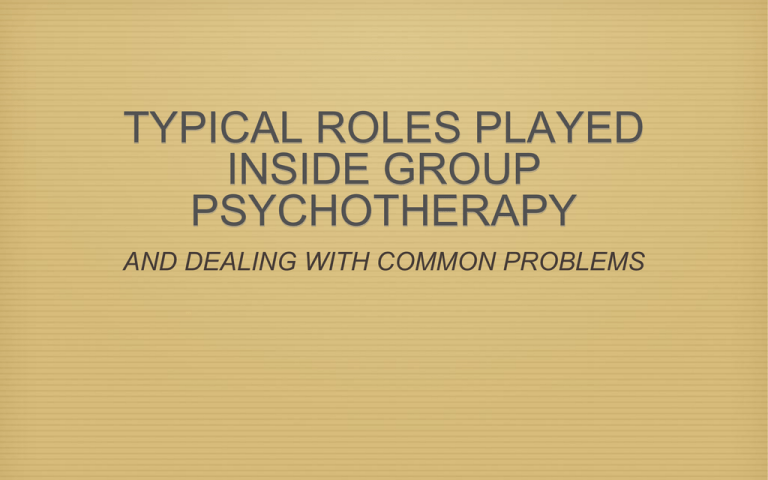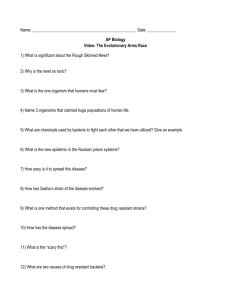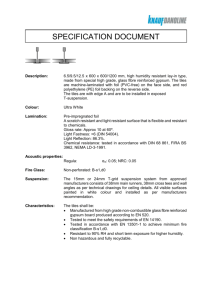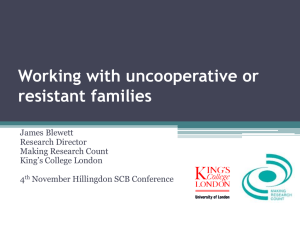TYPICAL ROLES PLAYED INSIDE GROUP PSYCHOTHERAPY AND DEALING WITH COMMON PROBLEMS
advertisement

TYPICAL ROLES PLAYED INSIDE GROUP PSYCHOTHERAPY AND DEALING WITH COMMON PROBLEMS TYPICAL ROLES PLAYED INSIDE GROUP PSYCHOTHERAPY AND DEALING WITH COMMON PROBLEMS Chronic Talker Characterized by persistent rambling and repetition Other members may not get chance to talk Group members will tune out or become disinterested Three types Nervous (first to answer, alleviate anxiety, watch how much time is given) Rambler (unaware of effect on others/ trivial) Show-off (insecure, wants to impress leader, other members, divert groups attention) Dealing with chronic talker Clues - how long have they been talking? Compare comments with other members Are comments in line with theme / here and now Is he/she truly preventing others from talking... Do other folks use this person to hide? Eventually use group’s power to look into... So does anyone notice what is going on here? Does anyone notice M’s pattern? The Dominator Tries to rule the group May not talk alot Can be quiet, potentially “the observer”, easily triggered uses this to keep group away Leader needs to sometime take risk pointing out this behavior to the group member or group as a whole technique Sometimes told to leave - sometimes meet with group leader outside group The Distracter Seeks attention or avoids looking at self May bring up unrelated questions Unconsciously creates transference and then feigns understanding their role in the transference collusion May make noises, move around May not be intentionally trying to distract - “it’s their defense mechanism” Group as a whole challenges; Is the member aware? Don’t let them turn it into a game - don’t let the rescuer or rescuers in group rescue or side with distracter The Rescuing Member He or she smoothes over negative feelings experienced by themselves and other group members Play the not safe card - “I think someone is being attacked” Or uses... “don’t worry it will be all right, everything has a way of working out” Essentially member won’t grow and group may not allow others to grow (anxious types) The Negative Member Constant complainer Disagrees with other members in the group or tries to use other members to punish the group leader or leaders in feeling that they are bad or have created an unsafe environment Look for and seek out originations of negative members transference distortion May need to talk outside group with negative member or utilizing linked members get them to direct question to negative member(s) If negative member is toxic - use little eye contact Try not to argue with negative member; instead in the here now point out discrepant behavior / thoughts / feelings The Resistant Member Caveat - some members are resistant because they are forced to be in the group Mandated clients The Resistant Member (cont.). Often outwardly angry or inwardly angry Sits with arms crossed, leaves jacket on, or have objects of distraction near (watch for body language - may also sit in same chair) Tries to focus “group” on topics not relevant May not be resistant to the group outwardly - but is resistant toward changing or challenging something inside themselves The Resistant Member (cont.). May have negative expectations about the effectiveness; believe the group will not be helpful Two primary techniques 1) gently massage to share feelings, 2) group therapist may hint at the feelings, go out on limb - “okay, this has been my experience of you...” Watch for instances when resistant member is open to group members insights and not leader (this is okay) so long as the resistant member is not purposely casting stones Get the Leader Member Members who more than not disagrees with leader or greater fraction of group members Can also show up in not following instructions Asking unanswerable questions or talk themselves into a corner and then blame group leader or members Different than negative member - where “getter” is truly looking to make leader look stupid, punish him or her Get the Leader (cont.). Working with involves not attacking, but challenging, don’t get into power struggles Sharing how as the leader you feel and think about what is going with get the leader member “I feel this way when I see, observe, I can’t help reacting... Who else in your life do you communicate this way ... point out what you are seeing - don’t blame Leader shares their flaws, uncertainties, and apologizing if ruptured the alliance - but no care-taking and de-selfing (massage) Silent Member Seek out the source behind the silent member “are they observers”? Will the group grow as far as it might with one member remaining silent - check-out the counter-transference... (“leader do your work”) What does the silence mean for the silent member, what is the sound of silence - how do others members feel. Hostile, Prejudiced, Narrow-Minded or Insensitive member First off - what are the norms - make this clear in the beginning - you can’t use it as a bat, but you can use it as leverage!!! Restate the purpose of the group is... You consented to (be therapeutic when delivering this message) It is not always good leadership to always let members have their say!


